A Research Proposal on Critical Infrastructure Protection Strategies
VerifiedAdded on 2022/08/19
|14
|3508
|36
Report
AI Summary
This report presents a research proposal focused on critical infrastructure protection. It begins with a definition of critical infrastructure and discusses the importance of protection strategies, supported by a literature review. The proposal emphasizes the role of information and intelligence sharing as a key strategy. The methodology section outlines a descriptive research design using secondary research methods, including textual analysis of scholarly sources. The findings highlight the significance of information sharing among various organizations in mitigating threats to critical infrastructure, particularly in the context of cybersecurity and technological advancements. The research underscores the importance of decision-making systems and critical thinking in risk reduction. The study aims to understand how information and intelligence sharing can be effective in managing and reducing threats to a nation's critical infrastructures.
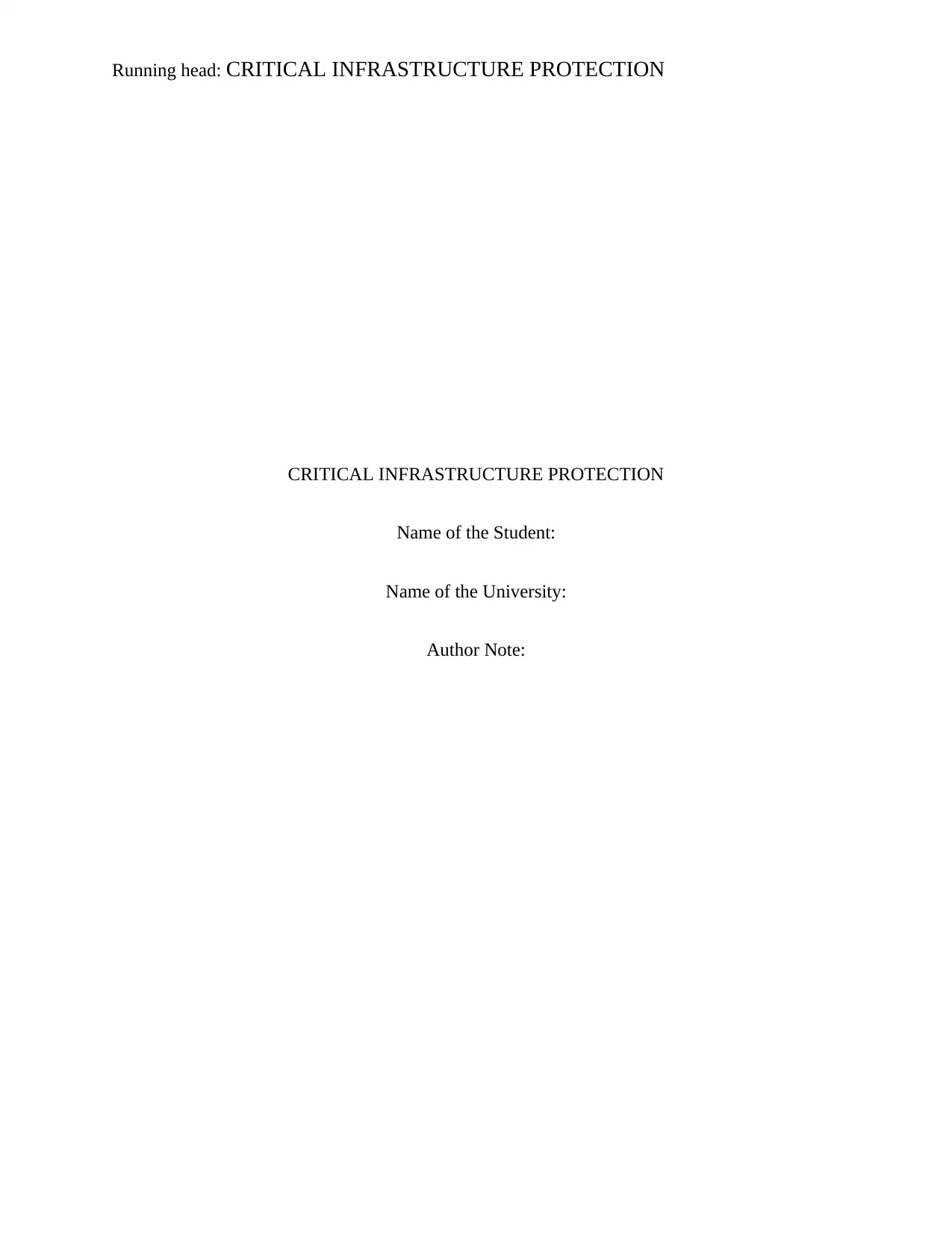
Running head: CRITICAL INFRASTRUCTURE PROTECTION
CRITICAL INFRASTRUCTURE PROTECTION
Name of the Student:
Name of the University:
Author Note:
CRITICAL INFRASTRUCTURE PROTECTION
Name of the Student:
Name of the University:
Author Note:
Paraphrase This Document
Need a fresh take? Get an instant paraphrase of this document with our AI Paraphraser
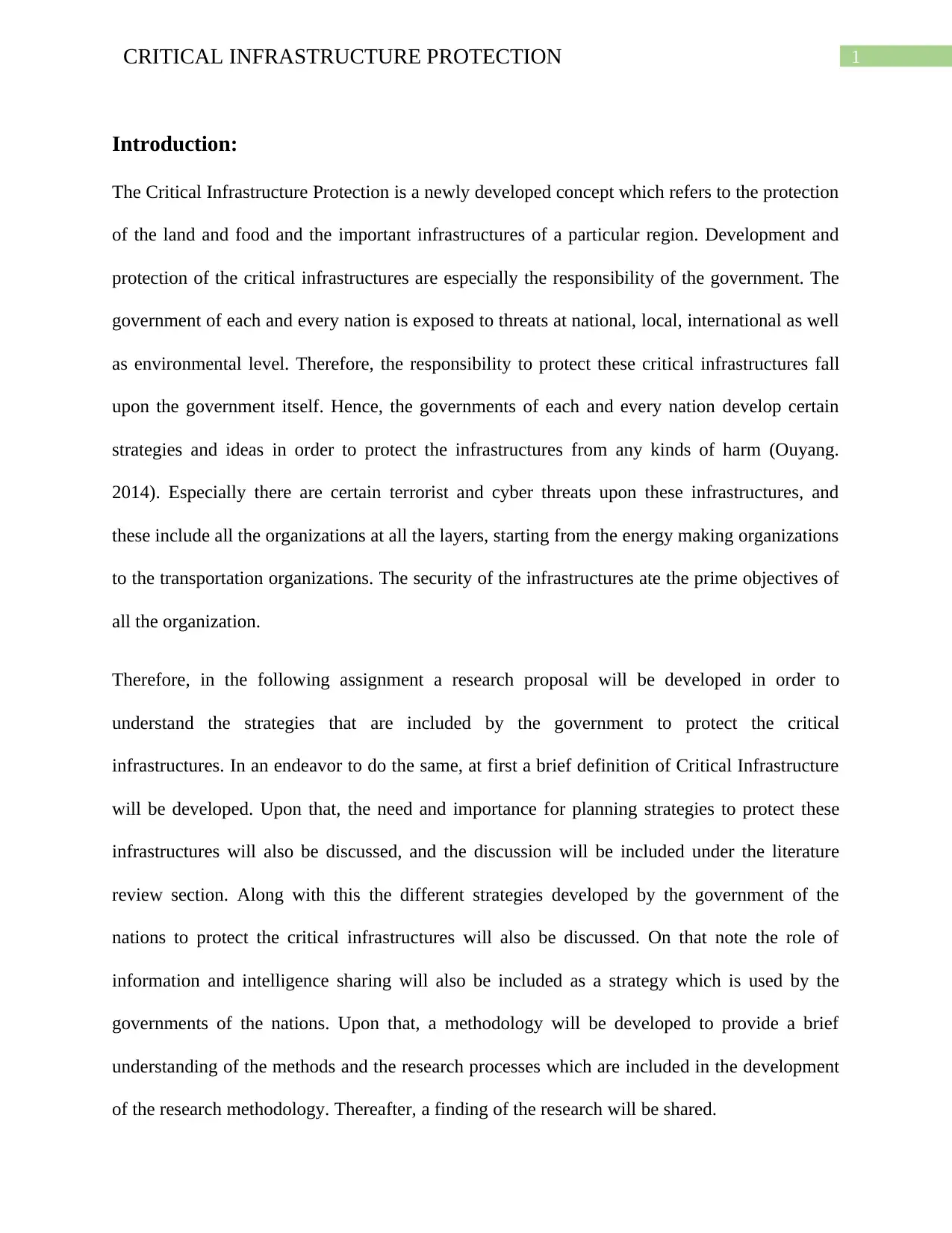
1CRITICAL INFRASTRUCTURE PROTECTION
Introduction:
The Critical Infrastructure Protection is a newly developed concept which refers to the protection
of the land and food and the important infrastructures of a particular region. Development and
protection of the critical infrastructures are especially the responsibility of the government. The
government of each and every nation is exposed to threats at national, local, international as well
as environmental level. Therefore, the responsibility to protect these critical infrastructures fall
upon the government itself. Hence, the governments of each and every nation develop certain
strategies and ideas in order to protect the infrastructures from any kinds of harm (Ouyang.
2014). Especially there are certain terrorist and cyber threats upon these infrastructures, and
these include all the organizations at all the layers, starting from the energy making organizations
to the transportation organizations. The security of the infrastructures ate the prime objectives of
all the organization.
Therefore, in the following assignment a research proposal will be developed in order to
understand the strategies that are included by the government to protect the critical
infrastructures. In an endeavor to do the same, at first a brief definition of Critical Infrastructure
will be developed. Upon that, the need and importance for planning strategies to protect these
infrastructures will also be discussed, and the discussion will be included under the literature
review section. Along with this the different strategies developed by the government of the
nations to protect the critical infrastructures will also be discussed. On that note the role of
information and intelligence sharing will also be included as a strategy which is used by the
governments of the nations. Upon that, a methodology will be developed to provide a brief
understanding of the methods and the research processes which are included in the development
of the research methodology. Thereafter, a finding of the research will be shared.
Introduction:
The Critical Infrastructure Protection is a newly developed concept which refers to the protection
of the land and food and the important infrastructures of a particular region. Development and
protection of the critical infrastructures are especially the responsibility of the government. The
government of each and every nation is exposed to threats at national, local, international as well
as environmental level. Therefore, the responsibility to protect these critical infrastructures fall
upon the government itself. Hence, the governments of each and every nation develop certain
strategies and ideas in order to protect the infrastructures from any kinds of harm (Ouyang.
2014). Especially there are certain terrorist and cyber threats upon these infrastructures, and
these include all the organizations at all the layers, starting from the energy making organizations
to the transportation organizations. The security of the infrastructures ate the prime objectives of
all the organization.
Therefore, in the following assignment a research proposal will be developed in order to
understand the strategies that are included by the government to protect the critical
infrastructures. In an endeavor to do the same, at first a brief definition of Critical Infrastructure
will be developed. Upon that, the need and importance for planning strategies to protect these
infrastructures will also be discussed, and the discussion will be included under the literature
review section. Along with this the different strategies developed by the government of the
nations to protect the critical infrastructures will also be discussed. On that note the role of
information and intelligence sharing will also be included as a strategy which is used by the
governments of the nations. Upon that, a methodology will be developed to provide a brief
understanding of the methods and the research processes which are included in the development
of the research methodology. Thereafter, a finding of the research will be shared.
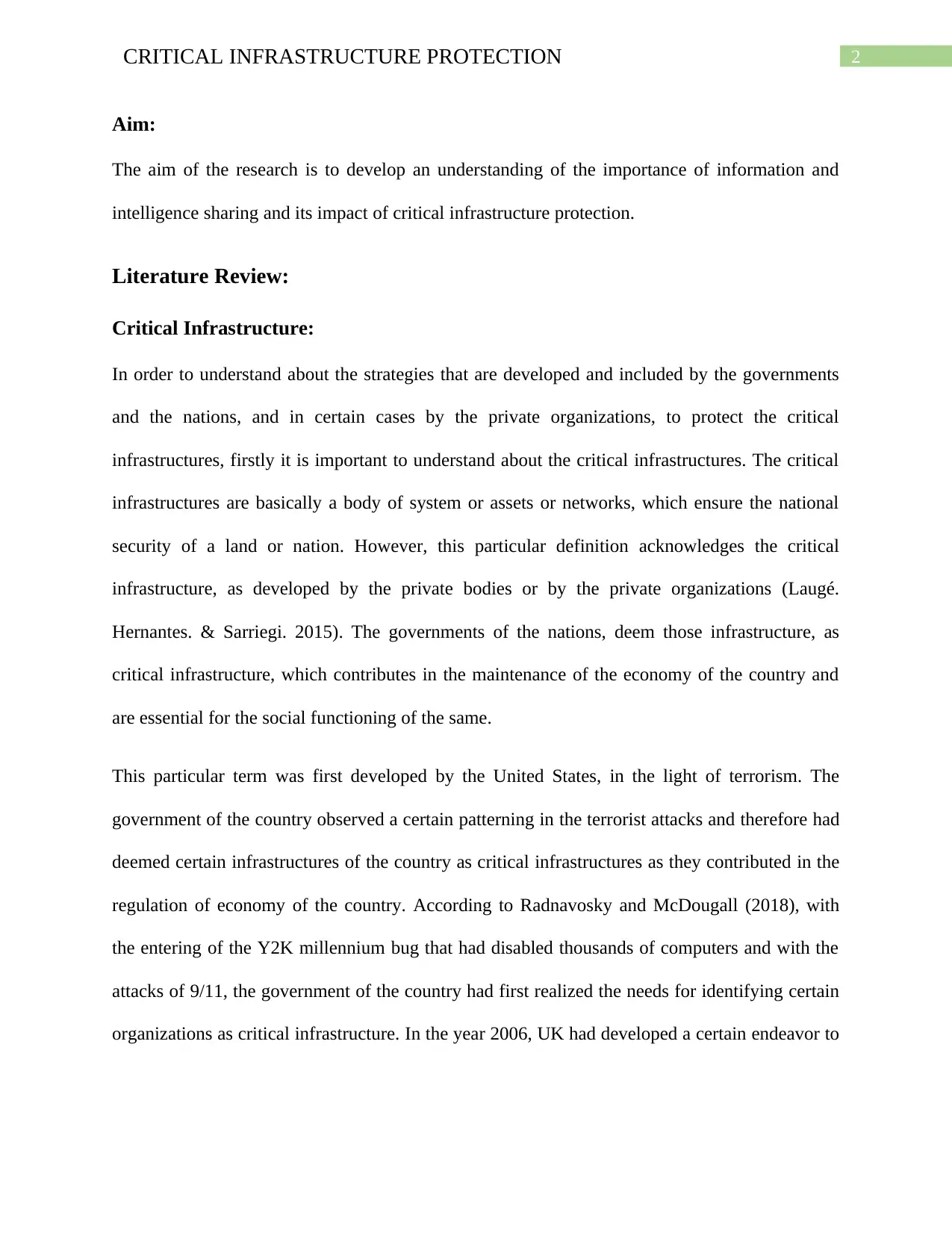
2CRITICAL INFRASTRUCTURE PROTECTION
Aim:
The aim of the research is to develop an understanding of the importance of information and
intelligence sharing and its impact of critical infrastructure protection.
Literature Review:
Critical Infrastructure:
In order to understand about the strategies that are developed and included by the governments
and the nations, and in certain cases by the private organizations, to protect the critical
infrastructures, firstly it is important to understand about the critical infrastructures. The critical
infrastructures are basically a body of system or assets or networks, which ensure the national
security of a land or nation. However, this particular definition acknowledges the critical
infrastructure, as developed by the private bodies or by the private organizations (Laugé.
Hernantes. & Sarriegi. 2015). The governments of the nations, deem those infrastructure, as
critical infrastructure, which contributes in the maintenance of the economy of the country and
are essential for the social functioning of the same.
This particular term was first developed by the United States, in the light of terrorism. The
government of the country observed a certain patterning in the terrorist attacks and therefore had
deemed certain infrastructures of the country as critical infrastructures as they contributed in the
regulation of economy of the country. According to Radnavosky and McDougall (2018), with
the entering of the Y2K millennium bug that had disabled thousands of computers and with the
attacks of 9/11, the government of the country had first realized the needs for identifying certain
organizations as critical infrastructure. In the year 2006, UK had developed a certain endeavor to
Aim:
The aim of the research is to develop an understanding of the importance of information and
intelligence sharing and its impact of critical infrastructure protection.
Literature Review:
Critical Infrastructure:
In order to understand about the strategies that are developed and included by the governments
and the nations, and in certain cases by the private organizations, to protect the critical
infrastructures, firstly it is important to understand about the critical infrastructures. The critical
infrastructures are basically a body of system or assets or networks, which ensure the national
security of a land or nation. However, this particular definition acknowledges the critical
infrastructure, as developed by the private bodies or by the private organizations (Laugé.
Hernantes. & Sarriegi. 2015). The governments of the nations, deem those infrastructure, as
critical infrastructure, which contributes in the maintenance of the economy of the country and
are essential for the social functioning of the same.
This particular term was first developed by the United States, in the light of terrorism. The
government of the country observed a certain patterning in the terrorist attacks and therefore had
deemed certain infrastructures of the country as critical infrastructures as they contributed in the
regulation of economy of the country. According to Radnavosky and McDougall (2018), with
the entering of the Y2K millennium bug that had disabled thousands of computers and with the
attacks of 9/11, the government of the country had first realized the needs for identifying certain
organizations as critical infrastructure. In the year 2006, UK had developed a certain endeavor to
⊘ This is a preview!⊘
Do you want full access?
Subscribe today to unlock all pages.

Trusted by 1+ million students worldwide

3CRITICAL INFRASTRUCTURE PROTECTION
protect the critical infrastructures and it is based on the input numbers provided by the member
states.
Now, the organizations which are included under the category of critical infrastructure, include,
national shelters; the national energy generating organization including natural gas, fuel oil,
renewable energy generating systems and the like; the infrastructure for food production and the
system and the infrastructure of food distribution; the systems and the infrastructures for water
supply including both the drinking water and the bodies for managing the sewage water; the
infrastructures for public health like the public hospitals and the ambulances; the security
services like the police services and the military services; the infrastructures for electricity
generation and the transportation systems and infrastructures like the railways, the harbors and
the airports, the inland shipping services and the telecommunication systems and the
infrastructures for the same (Baggett. & Simpkins. 2018). It also includes certain economic
infrastructures like the national banking houses and the clearing services, the infrastructures for
the exchange services and the like. Thus, the critical infrastructure refers to both the physical and
the non- physical structures and the cyber resources of a nation, which are essential for the social
and the economic and the political functioning of the nations.
Skopik. Settanni. & Fiedler (2016), had opined that the European nations had first identified and
recognized the need to protect these national infrastructures, and therefore, the country had been
involved into developing proper laws for ensuring the maintenance and the security of the
infrastructures as well as ensuring the proper functioning of the same. The Protection of the
National Infrastructure of the United Kingdom had recognized the critical infrastructures as
being, the infrastructures, which includes the facilities, information, people, networks, accesses
and processes, functions, sites and all the other aspects which are necessary for the running and
protect the critical infrastructures and it is based on the input numbers provided by the member
states.
Now, the organizations which are included under the category of critical infrastructure, include,
national shelters; the national energy generating organization including natural gas, fuel oil,
renewable energy generating systems and the like; the infrastructure for food production and the
system and the infrastructure of food distribution; the systems and the infrastructures for water
supply including both the drinking water and the bodies for managing the sewage water; the
infrastructures for public health like the public hospitals and the ambulances; the security
services like the police services and the military services; the infrastructures for electricity
generation and the transportation systems and infrastructures like the railways, the harbors and
the airports, the inland shipping services and the telecommunication systems and the
infrastructures for the same (Baggett. & Simpkins. 2018). It also includes certain economic
infrastructures like the national banking houses and the clearing services, the infrastructures for
the exchange services and the like. Thus, the critical infrastructure refers to both the physical and
the non- physical structures and the cyber resources of a nation, which are essential for the social
and the economic and the political functioning of the nations.
Skopik. Settanni. & Fiedler (2016), had opined that the European nations had first identified and
recognized the need to protect these national infrastructures, and therefore, the country had been
involved into developing proper laws for ensuring the maintenance and the security of the
infrastructures as well as ensuring the proper functioning of the same. The Protection of the
National Infrastructure of the United Kingdom had recognized the critical infrastructures as
being, the infrastructures, which includes the facilities, information, people, networks, accesses
and processes, functions, sites and all the other aspects which are necessary for the running and
Paraphrase This Document
Need a fresh take? Get an instant paraphrase of this document with our AI Paraphraser
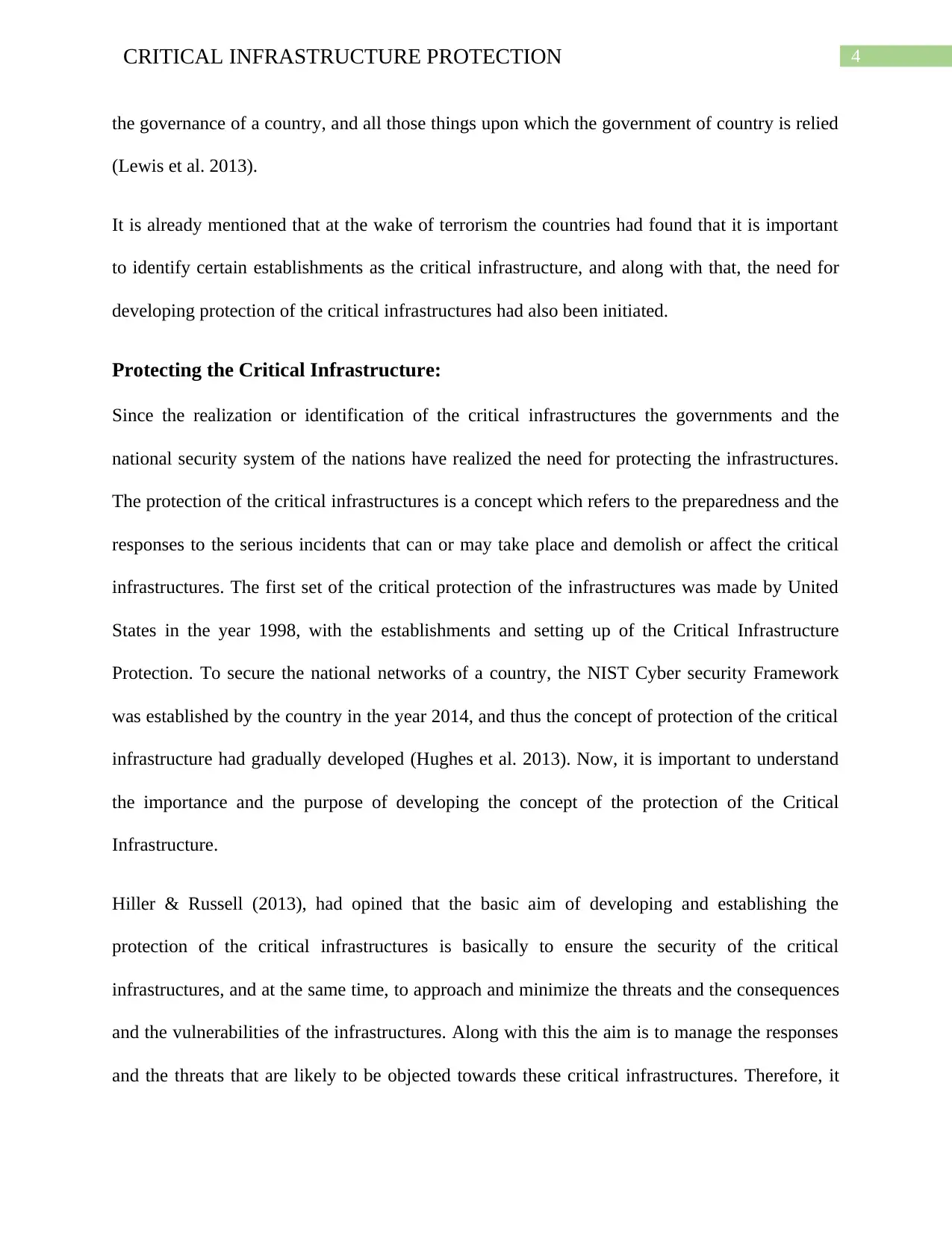
4CRITICAL INFRASTRUCTURE PROTECTION
the governance of a country, and all those things upon which the government of country is relied
(Lewis et al. 2013).
It is already mentioned that at the wake of terrorism the countries had found that it is important
to identify certain establishments as the critical infrastructure, and along with that, the need for
developing protection of the critical infrastructures had also been initiated.
Protecting the Critical Infrastructure:
Since the realization or identification of the critical infrastructures the governments and the
national security system of the nations have realized the need for protecting the infrastructures.
The protection of the critical infrastructures is a concept which refers to the preparedness and the
responses to the serious incidents that can or may take place and demolish or affect the critical
infrastructures. The first set of the critical protection of the infrastructures was made by United
States in the year 1998, with the establishments and setting up of the Critical Infrastructure
Protection. To secure the national networks of a country, the NIST Cyber security Framework
was established by the country in the year 2014, and thus the concept of protection of the critical
infrastructure had gradually developed (Hughes et al. 2013). Now, it is important to understand
the importance and the purpose of developing the concept of the protection of the Critical
Infrastructure.
Hiller & Russell (2013), had opined that the basic aim of developing and establishing the
protection of the critical infrastructures is basically to ensure the security of the critical
infrastructures, and at the same time, to approach and minimize the threats and the consequences
and the vulnerabilities of the infrastructures. Along with this the aim is to manage the responses
and the threats that are likely to be objected towards these critical infrastructures. Therefore, it
the governance of a country, and all those things upon which the government of country is relied
(Lewis et al. 2013).
It is already mentioned that at the wake of terrorism the countries had found that it is important
to identify certain establishments as the critical infrastructure, and along with that, the need for
developing protection of the critical infrastructures had also been initiated.
Protecting the Critical Infrastructure:
Since the realization or identification of the critical infrastructures the governments and the
national security system of the nations have realized the need for protecting the infrastructures.
The protection of the critical infrastructures is a concept which refers to the preparedness and the
responses to the serious incidents that can or may take place and demolish or affect the critical
infrastructures. The first set of the critical protection of the infrastructures was made by United
States in the year 1998, with the establishments and setting up of the Critical Infrastructure
Protection. To secure the national networks of a country, the NIST Cyber security Framework
was established by the country in the year 2014, and thus the concept of protection of the critical
infrastructure had gradually developed (Hughes et al. 2013). Now, it is important to understand
the importance and the purpose of developing the concept of the protection of the Critical
Infrastructure.
Hiller & Russell (2013), had opined that the basic aim of developing and establishing the
protection of the critical infrastructures is basically to ensure the security of the critical
infrastructures, and at the same time, to approach and minimize the threats and the consequences
and the vulnerabilities of the infrastructures. Along with this the aim is to manage the responses
and the threats that are likely to be objected towards these critical infrastructures. Therefore, it
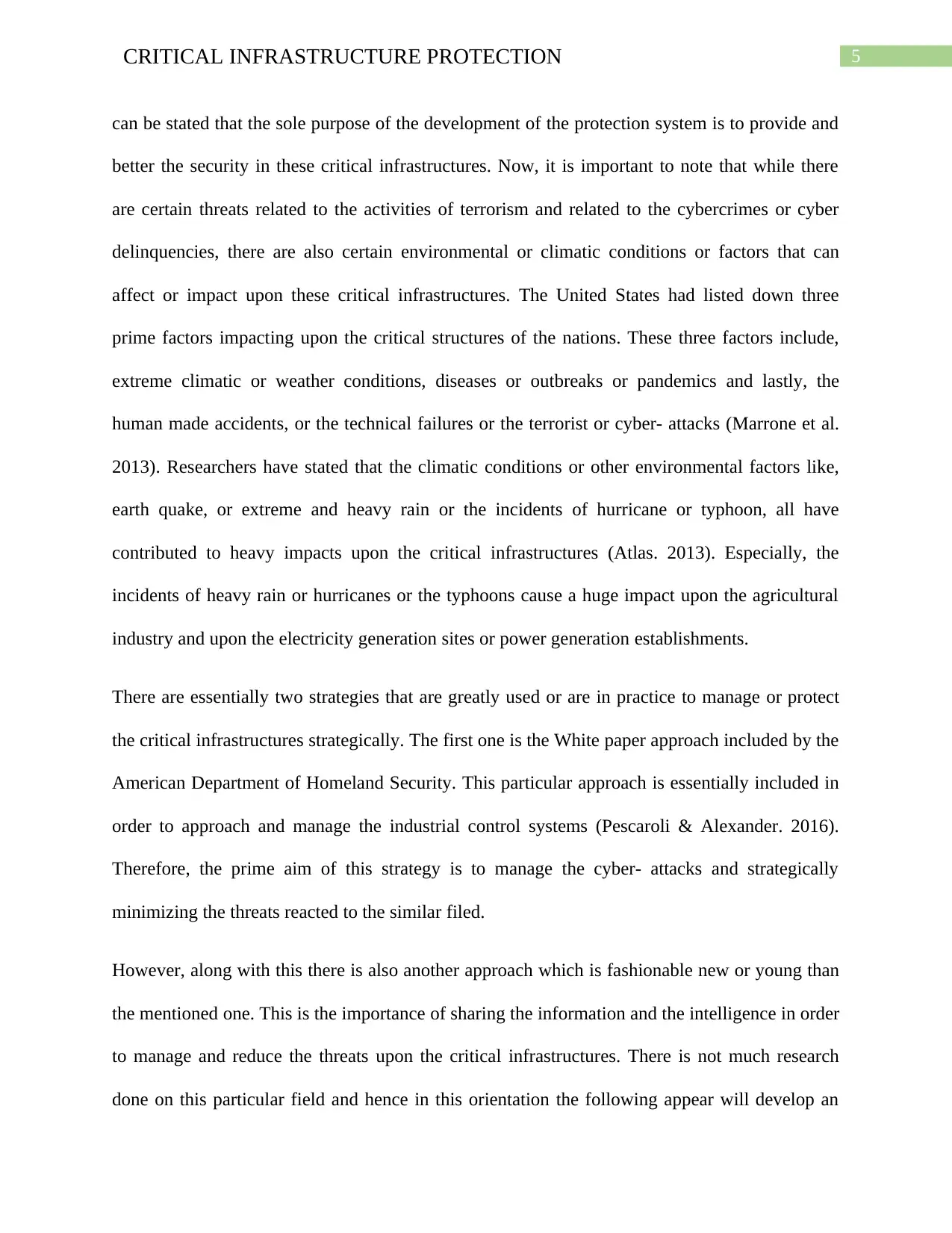
5CRITICAL INFRASTRUCTURE PROTECTION
can be stated that the sole purpose of the development of the protection system is to provide and
better the security in these critical infrastructures. Now, it is important to note that while there
are certain threats related to the activities of terrorism and related to the cybercrimes or cyber
delinquencies, there are also certain environmental or climatic conditions or factors that can
affect or impact upon these critical infrastructures. The United States had listed down three
prime factors impacting upon the critical structures of the nations. These three factors include,
extreme climatic or weather conditions, diseases or outbreaks or pandemics and lastly, the
human made accidents, or the technical failures or the terrorist or cyber- attacks (Marrone et al.
2013). Researchers have stated that the climatic conditions or other environmental factors like,
earth quake, or extreme and heavy rain or the incidents of hurricane or typhoon, all have
contributed to heavy impacts upon the critical infrastructures (Atlas. 2013). Especially, the
incidents of heavy rain or hurricanes or the typhoons cause a huge impact upon the agricultural
industry and upon the electricity generation sites or power generation establishments.
There are essentially two strategies that are greatly used or are in practice to manage or protect
the critical infrastructures strategically. The first one is the White paper approach included by the
American Department of Homeland Security. This particular approach is essentially included in
order to approach and manage the industrial control systems (Pescaroli & Alexander. 2016).
Therefore, the prime aim of this strategy is to manage the cyber- attacks and strategically
minimizing the threats reacted to the similar filed.
However, along with this there is also another approach which is fashionable new or young than
the mentioned one. This is the importance of sharing the information and the intelligence in order
to manage and reduce the threats upon the critical infrastructures. There is not much research
done on this particular field and hence in this orientation the following appear will develop an
can be stated that the sole purpose of the development of the protection system is to provide and
better the security in these critical infrastructures. Now, it is important to note that while there
are certain threats related to the activities of terrorism and related to the cybercrimes or cyber
delinquencies, there are also certain environmental or climatic conditions or factors that can
affect or impact upon these critical infrastructures. The United States had listed down three
prime factors impacting upon the critical structures of the nations. These three factors include,
extreme climatic or weather conditions, diseases or outbreaks or pandemics and lastly, the
human made accidents, or the technical failures or the terrorist or cyber- attacks (Marrone et al.
2013). Researchers have stated that the climatic conditions or other environmental factors like,
earth quake, or extreme and heavy rain or the incidents of hurricane or typhoon, all have
contributed to heavy impacts upon the critical infrastructures (Atlas. 2013). Especially, the
incidents of heavy rain or hurricanes or the typhoons cause a huge impact upon the agricultural
industry and upon the electricity generation sites or power generation establishments.
There are essentially two strategies that are greatly used or are in practice to manage or protect
the critical infrastructures strategically. The first one is the White paper approach included by the
American Department of Homeland Security. This particular approach is essentially included in
order to approach and manage the industrial control systems (Pescaroli & Alexander. 2016).
Therefore, the prime aim of this strategy is to manage the cyber- attacks and strategically
minimizing the threats reacted to the similar filed.
However, along with this there is also another approach which is fashionable new or young than
the mentioned one. This is the importance of sharing the information and the intelligence in order
to manage and reduce the threats upon the critical infrastructures. There is not much research
done on this particular field and hence in this orientation the following appear will develop an
⊘ This is a preview!⊘
Do you want full access?
Subscribe today to unlock all pages.

Trusted by 1+ million students worldwide
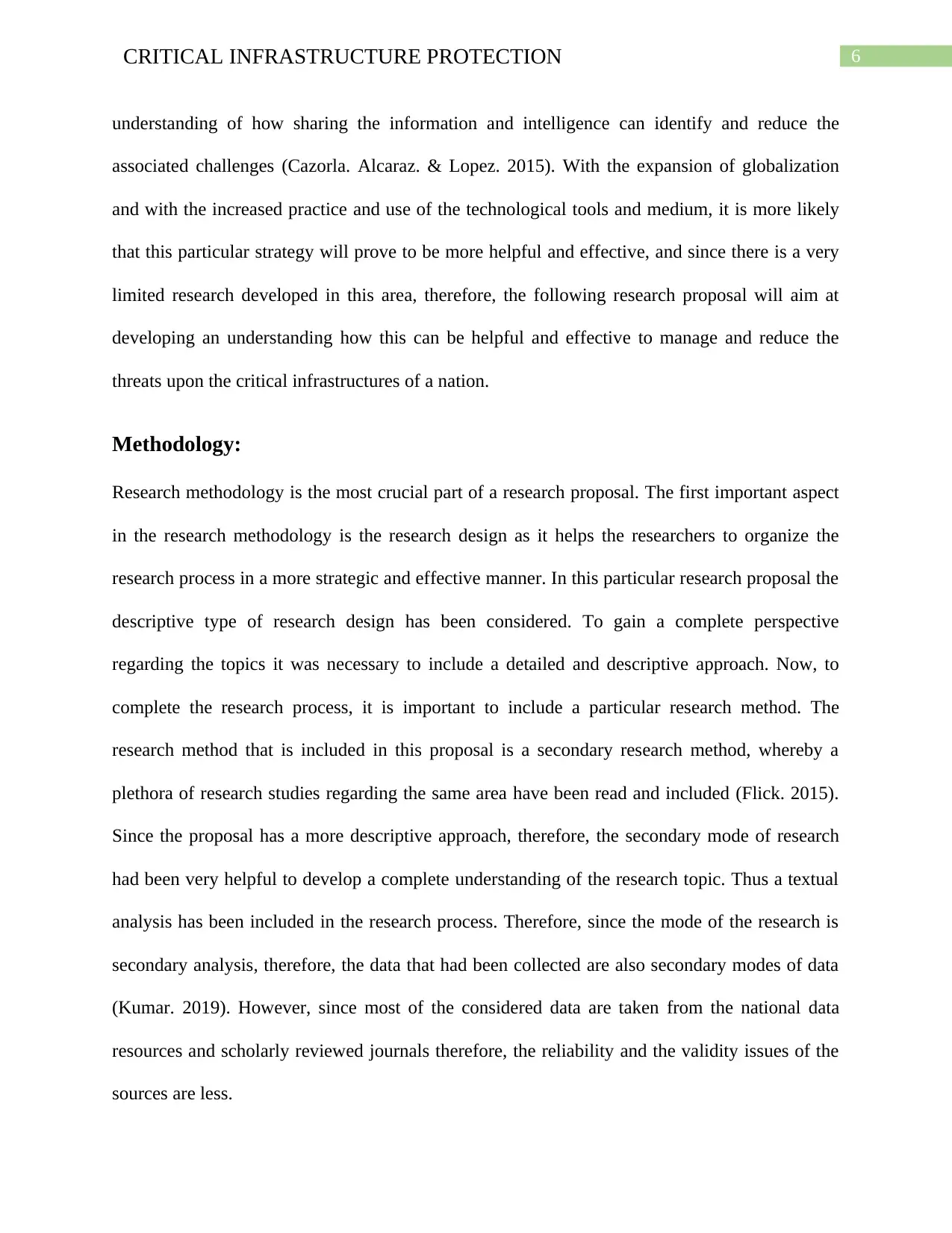
6CRITICAL INFRASTRUCTURE PROTECTION
understanding of how sharing the information and intelligence can identify and reduce the
associated challenges (Cazorla. Alcaraz. & Lopez. 2015). With the expansion of globalization
and with the increased practice and use of the technological tools and medium, it is more likely
that this particular strategy will prove to be more helpful and effective, and since there is a very
limited research developed in this area, therefore, the following research proposal will aim at
developing an understanding how this can be helpful and effective to manage and reduce the
threats upon the critical infrastructures of a nation.
Methodology:
Research methodology is the most crucial part of a research proposal. The first important aspect
in the research methodology is the research design as it helps the researchers to organize the
research process in a more strategic and effective manner. In this particular research proposal the
descriptive type of research design has been considered. To gain a complete perspective
regarding the topics it was necessary to include a detailed and descriptive approach. Now, to
complete the research process, it is important to include a particular research method. The
research method that is included in this proposal is a secondary research method, whereby a
plethora of research studies regarding the same area have been read and included (Flick. 2015).
Since the proposal has a more descriptive approach, therefore, the secondary mode of research
had been very helpful to develop a complete understanding of the research topic. Thus a textual
analysis has been included in the research process. Therefore, since the mode of the research is
secondary analysis, therefore, the data that had been collected are also secondary modes of data
(Kumar. 2019). However, since most of the considered data are taken from the national data
resources and scholarly reviewed journals therefore, the reliability and the validity issues of the
sources are less.
understanding of how sharing the information and intelligence can identify and reduce the
associated challenges (Cazorla. Alcaraz. & Lopez. 2015). With the expansion of globalization
and with the increased practice and use of the technological tools and medium, it is more likely
that this particular strategy will prove to be more helpful and effective, and since there is a very
limited research developed in this area, therefore, the following research proposal will aim at
developing an understanding how this can be helpful and effective to manage and reduce the
threats upon the critical infrastructures of a nation.
Methodology:
Research methodology is the most crucial part of a research proposal. The first important aspect
in the research methodology is the research design as it helps the researchers to organize the
research process in a more strategic and effective manner. In this particular research proposal the
descriptive type of research design has been considered. To gain a complete perspective
regarding the topics it was necessary to include a detailed and descriptive approach. Now, to
complete the research process, it is important to include a particular research method. The
research method that is included in this proposal is a secondary research method, whereby a
plethora of research studies regarding the same area have been read and included (Flick. 2015).
Since the proposal has a more descriptive approach, therefore, the secondary mode of research
had been very helpful to develop a complete understanding of the research topic. Thus a textual
analysis has been included in the research process. Therefore, since the mode of the research is
secondary analysis, therefore, the data that had been collected are also secondary modes of data
(Kumar. 2019). However, since most of the considered data are taken from the national data
resources and scholarly reviewed journals therefore, the reliability and the validity issues of the
sources are less.
Paraphrase This Document
Need a fresh take? Get an instant paraphrase of this document with our AI Paraphraser
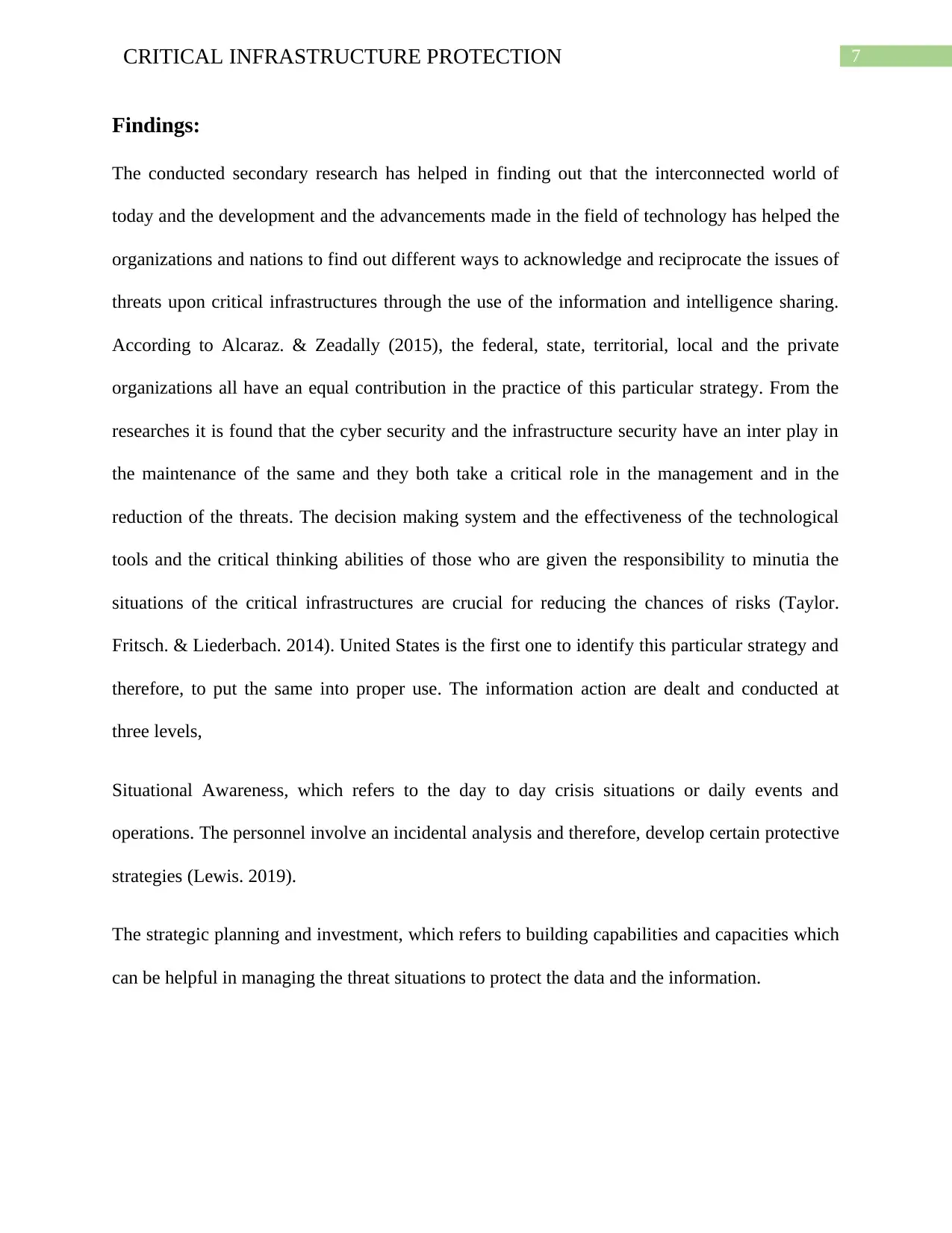
7CRITICAL INFRASTRUCTURE PROTECTION
Findings:
The conducted secondary research has helped in finding out that the interconnected world of
today and the development and the advancements made in the field of technology has helped the
organizations and nations to find out different ways to acknowledge and reciprocate the issues of
threats upon critical infrastructures through the use of the information and intelligence sharing.
According to Alcaraz. & Zeadally (2015), the federal, state, territorial, local and the private
organizations all have an equal contribution in the practice of this particular strategy. From the
researches it is found that the cyber security and the infrastructure security have an inter play in
the maintenance of the same and they both take a critical role in the management and in the
reduction of the threats. The decision making system and the effectiveness of the technological
tools and the critical thinking abilities of those who are given the responsibility to minutia the
situations of the critical infrastructures are crucial for reducing the chances of risks (Taylor.
Fritsch. & Liederbach. 2014). United States is the first one to identify this particular strategy and
therefore, to put the same into proper use. The information action are dealt and conducted at
three levels,
Situational Awareness, which refers to the day to day crisis situations or daily events and
operations. The personnel involve an incidental analysis and therefore, develop certain protective
strategies (Lewis. 2019).
The strategic planning and investment, which refers to building capabilities and capacities which
can be helpful in managing the threat situations to protect the data and the information.
Findings:
The conducted secondary research has helped in finding out that the interconnected world of
today and the development and the advancements made in the field of technology has helped the
organizations and nations to find out different ways to acknowledge and reciprocate the issues of
threats upon critical infrastructures through the use of the information and intelligence sharing.
According to Alcaraz. & Zeadally (2015), the federal, state, territorial, local and the private
organizations all have an equal contribution in the practice of this particular strategy. From the
researches it is found that the cyber security and the infrastructure security have an inter play in
the maintenance of the same and they both take a critical role in the management and in the
reduction of the threats. The decision making system and the effectiveness of the technological
tools and the critical thinking abilities of those who are given the responsibility to minutia the
situations of the critical infrastructures are crucial for reducing the chances of risks (Taylor.
Fritsch. & Liederbach. 2014). United States is the first one to identify this particular strategy and
therefore, to put the same into proper use. The information action are dealt and conducted at
three levels,
Situational Awareness, which refers to the day to day crisis situations or daily events and
operations. The personnel involve an incidental analysis and therefore, develop certain protective
strategies (Lewis. 2019).
The strategic planning and investment, which refers to building capabilities and capacities which
can be helpful in managing the threat situations to protect the data and the information.
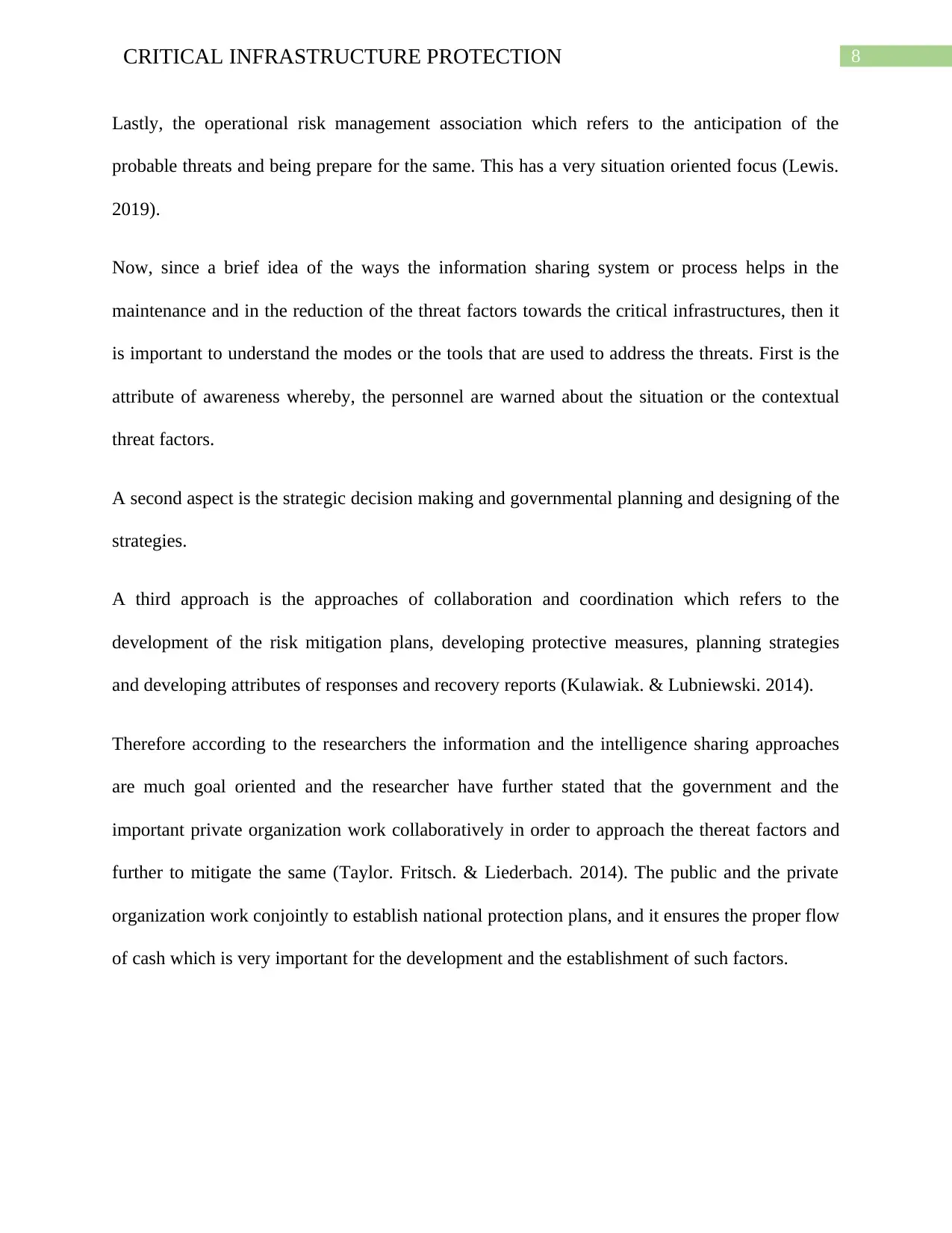
8CRITICAL INFRASTRUCTURE PROTECTION
Lastly, the operational risk management association which refers to the anticipation of the
probable threats and being prepare for the same. This has a very situation oriented focus (Lewis.
2019).
Now, since a brief idea of the ways the information sharing system or process helps in the
maintenance and in the reduction of the threat factors towards the critical infrastructures, then it
is important to understand the modes or the tools that are used to address the threats. First is the
attribute of awareness whereby, the personnel are warned about the situation or the contextual
threat factors.
A second aspect is the strategic decision making and governmental planning and designing of the
strategies.
A third approach is the approaches of collaboration and coordination which refers to the
development of the risk mitigation plans, developing protective measures, planning strategies
and developing attributes of responses and recovery reports (Kulawiak. & Lubniewski. 2014).
Therefore according to the researchers the information and the intelligence sharing approaches
are much goal oriented and the researcher have further stated that the government and the
important private organization work collaboratively in order to approach the thereat factors and
further to mitigate the same (Taylor. Fritsch. & Liederbach. 2014). The public and the private
organization work conjointly to establish national protection plans, and it ensures the proper flow
of cash which is very important for the development and the establishment of such factors.
Lastly, the operational risk management association which refers to the anticipation of the
probable threats and being prepare for the same. This has a very situation oriented focus (Lewis.
2019).
Now, since a brief idea of the ways the information sharing system or process helps in the
maintenance and in the reduction of the threat factors towards the critical infrastructures, then it
is important to understand the modes or the tools that are used to address the threats. First is the
attribute of awareness whereby, the personnel are warned about the situation or the contextual
threat factors.
A second aspect is the strategic decision making and governmental planning and designing of the
strategies.
A third approach is the approaches of collaboration and coordination which refers to the
development of the risk mitigation plans, developing protective measures, planning strategies
and developing attributes of responses and recovery reports (Kulawiak. & Lubniewski. 2014).
Therefore according to the researchers the information and the intelligence sharing approaches
are much goal oriented and the researcher have further stated that the government and the
important private organization work collaboratively in order to approach the thereat factors and
further to mitigate the same (Taylor. Fritsch. & Liederbach. 2014). The public and the private
organization work conjointly to establish national protection plans, and it ensures the proper flow
of cash which is very important for the development and the establishment of such factors.
⊘ This is a preview!⊘
Do you want full access?
Subscribe today to unlock all pages.

Trusted by 1+ million students worldwide
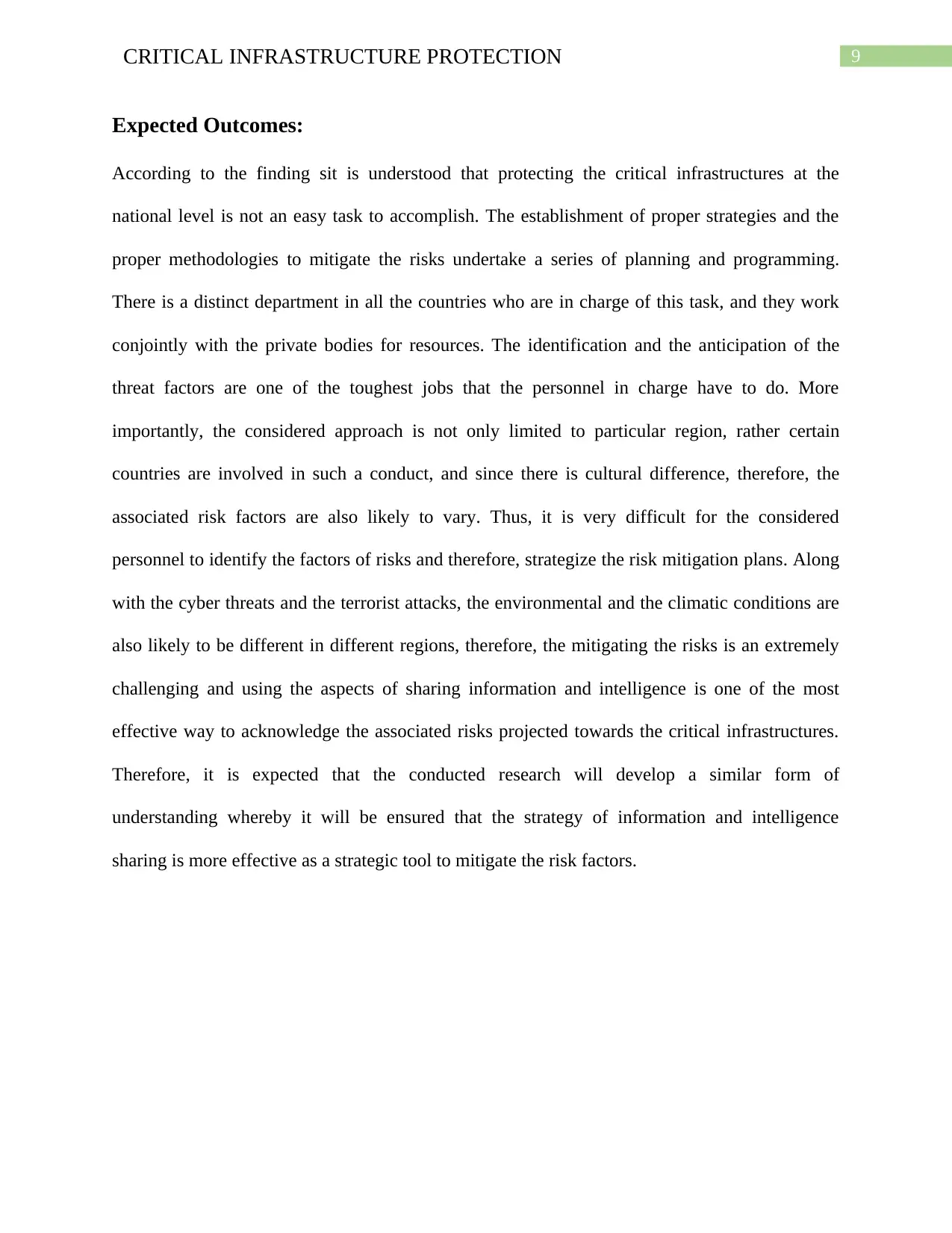
9CRITICAL INFRASTRUCTURE PROTECTION
Expected Outcomes:
According to the finding sit is understood that protecting the critical infrastructures at the
national level is not an easy task to accomplish. The establishment of proper strategies and the
proper methodologies to mitigate the risks undertake a series of planning and programming.
There is a distinct department in all the countries who are in charge of this task, and they work
conjointly with the private bodies for resources. The identification and the anticipation of the
threat factors are one of the toughest jobs that the personnel in charge have to do. More
importantly, the considered approach is not only limited to particular region, rather certain
countries are involved in such a conduct, and since there is cultural difference, therefore, the
associated risk factors are also likely to vary. Thus, it is very difficult for the considered
personnel to identify the factors of risks and therefore, strategize the risk mitigation plans. Along
with the cyber threats and the terrorist attacks, the environmental and the climatic conditions are
also likely to be different in different regions, therefore, the mitigating the risks is an extremely
challenging and using the aspects of sharing information and intelligence is one of the most
effective way to acknowledge the associated risks projected towards the critical infrastructures.
Therefore, it is expected that the conducted research will develop a similar form of
understanding whereby it will be ensured that the strategy of information and intelligence
sharing is more effective as a strategic tool to mitigate the risk factors.
Expected Outcomes:
According to the finding sit is understood that protecting the critical infrastructures at the
national level is not an easy task to accomplish. The establishment of proper strategies and the
proper methodologies to mitigate the risks undertake a series of planning and programming.
There is a distinct department in all the countries who are in charge of this task, and they work
conjointly with the private bodies for resources. The identification and the anticipation of the
threat factors are one of the toughest jobs that the personnel in charge have to do. More
importantly, the considered approach is not only limited to particular region, rather certain
countries are involved in such a conduct, and since there is cultural difference, therefore, the
associated risk factors are also likely to vary. Thus, it is very difficult for the considered
personnel to identify the factors of risks and therefore, strategize the risk mitigation plans. Along
with the cyber threats and the terrorist attacks, the environmental and the climatic conditions are
also likely to be different in different regions, therefore, the mitigating the risks is an extremely
challenging and using the aspects of sharing information and intelligence is one of the most
effective way to acknowledge the associated risks projected towards the critical infrastructures.
Therefore, it is expected that the conducted research will develop a similar form of
understanding whereby it will be ensured that the strategy of information and intelligence
sharing is more effective as a strategic tool to mitigate the risk factors.
Paraphrase This Document
Need a fresh take? Get an instant paraphrase of this document with our AI Paraphraser
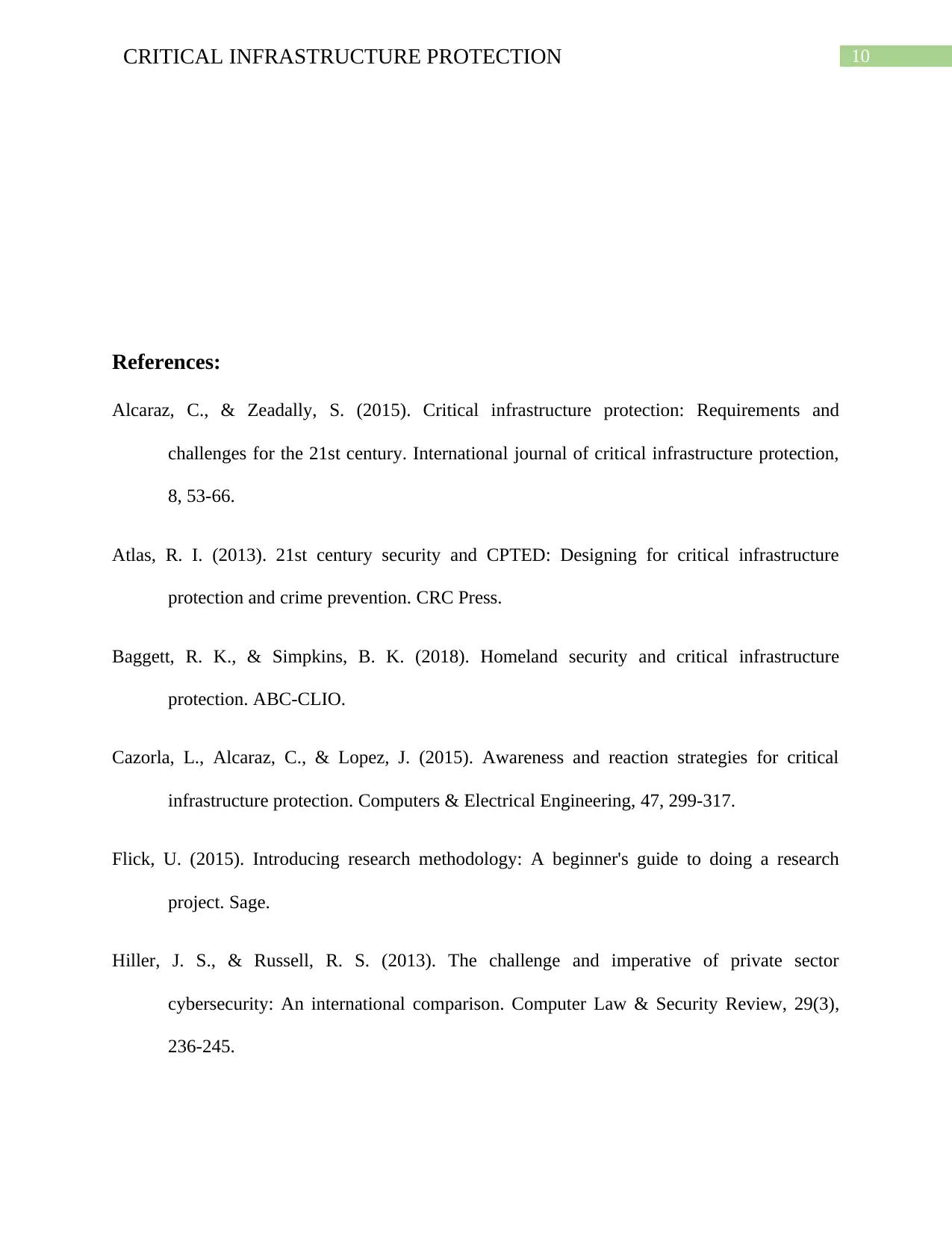
10CRITICAL INFRASTRUCTURE PROTECTION
References:
Alcaraz, C., & Zeadally, S. (2015). Critical infrastructure protection: Requirements and
challenges for the 21st century. International journal of critical infrastructure protection,
8, 53-66.
Atlas, R. I. (2013). 21st century security and CPTED: Designing for critical infrastructure
protection and crime prevention. CRC Press.
Baggett, R. K., & Simpkins, B. K. (2018). Homeland security and critical infrastructure
protection. ABC-CLIO.
Cazorla, L., Alcaraz, C., & Lopez, J. (2015). Awareness and reaction strategies for critical
infrastructure protection. Computers & Electrical Engineering, 47, 299-317.
Flick, U. (2015). Introducing research methodology: A beginner's guide to doing a research
project. Sage.
Hiller, J. S., & Russell, R. S. (2013). The challenge and imperative of private sector
cybersecurity: An international comparison. Computer Law & Security Review, 29(3),
236-245.
References:
Alcaraz, C., & Zeadally, S. (2015). Critical infrastructure protection: Requirements and
challenges for the 21st century. International journal of critical infrastructure protection,
8, 53-66.
Atlas, R. I. (2013). 21st century security and CPTED: Designing for critical infrastructure
protection and crime prevention. CRC Press.
Baggett, R. K., & Simpkins, B. K. (2018). Homeland security and critical infrastructure
protection. ABC-CLIO.
Cazorla, L., Alcaraz, C., & Lopez, J. (2015). Awareness and reaction strategies for critical
infrastructure protection. Computers & Electrical Engineering, 47, 299-317.
Flick, U. (2015). Introducing research methodology: A beginner's guide to doing a research
project. Sage.
Hiller, J. S., & Russell, R. S. (2013). The challenge and imperative of private sector
cybersecurity: An international comparison. Computer Law & Security Review, 29(3),
236-245.
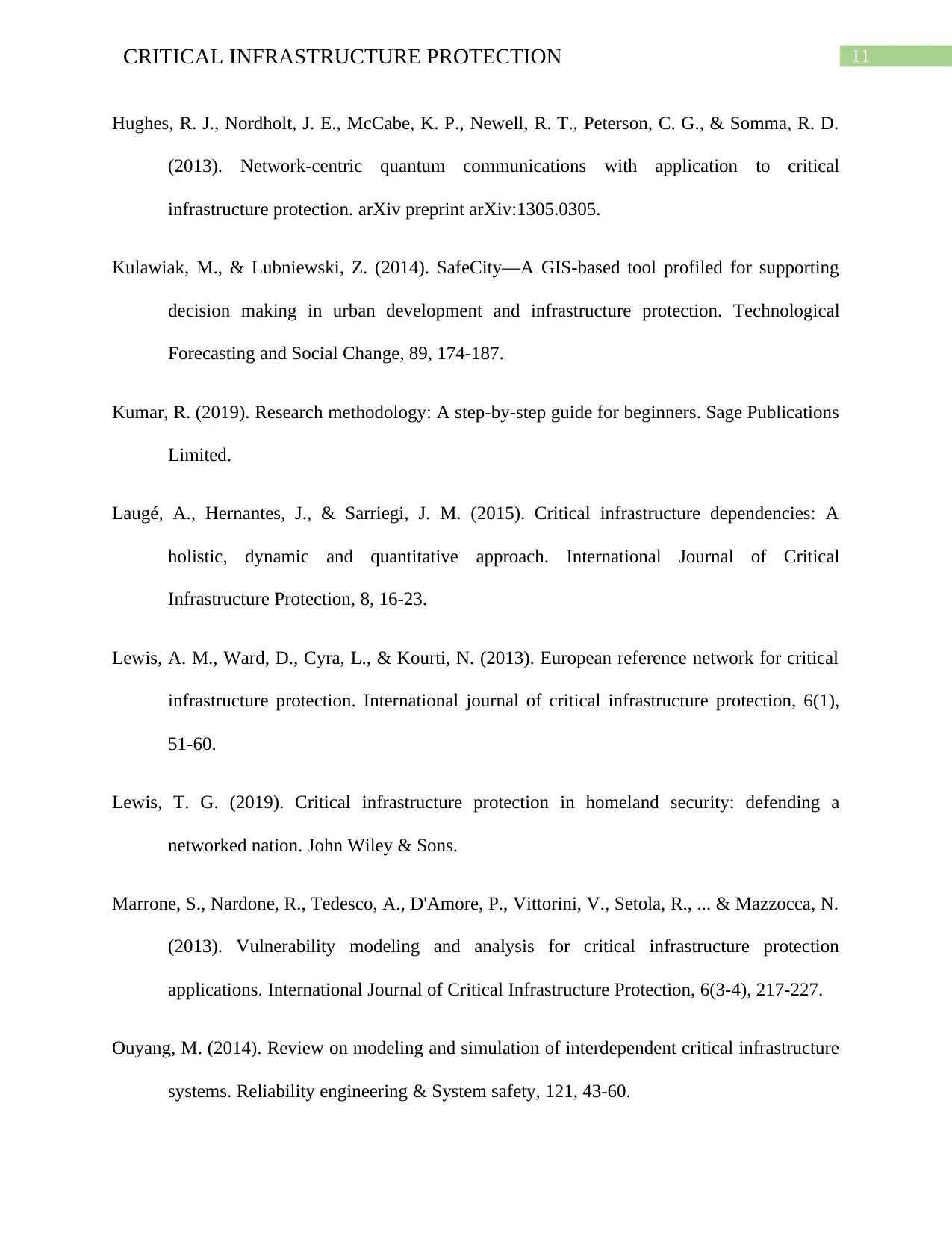
11CRITICAL INFRASTRUCTURE PROTECTION
Hughes, R. J., Nordholt, J. E., McCabe, K. P., Newell, R. T., Peterson, C. G., & Somma, R. D.
(2013). Network-centric quantum communications with application to critical
infrastructure protection. arXiv preprint arXiv:1305.0305.
Kulawiak, M., & Lubniewski, Z. (2014). SafeCity—A GIS-based tool profiled for supporting
decision making in urban development and infrastructure protection. Technological
Forecasting and Social Change, 89, 174-187.
Kumar, R. (2019). Research methodology: A step-by-step guide for beginners. Sage Publications
Limited.
Laugé, A., Hernantes, J., & Sarriegi, J. M. (2015). Critical infrastructure dependencies: A
holistic, dynamic and quantitative approach. International Journal of Critical
Infrastructure Protection, 8, 16-23.
Lewis, A. M., Ward, D., Cyra, L., & Kourti, N. (2013). European reference network for critical
infrastructure protection. International journal of critical infrastructure protection, 6(1),
51-60.
Lewis, T. G. (2019). Critical infrastructure protection in homeland security: defending a
networked nation. John Wiley & Sons.
Marrone, S., Nardone, R., Tedesco, A., D'Amore, P., Vittorini, V., Setola, R., ... & Mazzocca, N.
(2013). Vulnerability modeling and analysis for critical infrastructure protection
applications. International Journal of Critical Infrastructure Protection, 6(3-4), 217-227.
Ouyang, M. (2014). Review on modeling and simulation of interdependent critical infrastructure
systems. Reliability engineering & System safety, 121, 43-60.
Hughes, R. J., Nordholt, J. E., McCabe, K. P., Newell, R. T., Peterson, C. G., & Somma, R. D.
(2013). Network-centric quantum communications with application to critical
infrastructure protection. arXiv preprint arXiv:1305.0305.
Kulawiak, M., & Lubniewski, Z. (2014). SafeCity—A GIS-based tool profiled for supporting
decision making in urban development and infrastructure protection. Technological
Forecasting and Social Change, 89, 174-187.
Kumar, R. (2019). Research methodology: A step-by-step guide for beginners. Sage Publications
Limited.
Laugé, A., Hernantes, J., & Sarriegi, J. M. (2015). Critical infrastructure dependencies: A
holistic, dynamic and quantitative approach. International Journal of Critical
Infrastructure Protection, 8, 16-23.
Lewis, A. M., Ward, D., Cyra, L., & Kourti, N. (2013). European reference network for critical
infrastructure protection. International journal of critical infrastructure protection, 6(1),
51-60.
Lewis, T. G. (2019). Critical infrastructure protection in homeland security: defending a
networked nation. John Wiley & Sons.
Marrone, S., Nardone, R., Tedesco, A., D'Amore, P., Vittorini, V., Setola, R., ... & Mazzocca, N.
(2013). Vulnerability modeling and analysis for critical infrastructure protection
applications. International Journal of Critical Infrastructure Protection, 6(3-4), 217-227.
Ouyang, M. (2014). Review on modeling and simulation of interdependent critical infrastructure
systems. Reliability engineering & System safety, 121, 43-60.
⊘ This is a preview!⊘
Do you want full access?
Subscribe today to unlock all pages.

Trusted by 1+ million students worldwide
1 out of 14
Related Documents
Your All-in-One AI-Powered Toolkit for Academic Success.
+13062052269
info@desklib.com
Available 24*7 on WhatsApp / Email
![[object Object]](/_next/static/media/star-bottom.7253800d.svg)
Unlock your academic potential
Copyright © 2020–2025 A2Z Services. All Rights Reserved. Developed and managed by ZUCOL.





